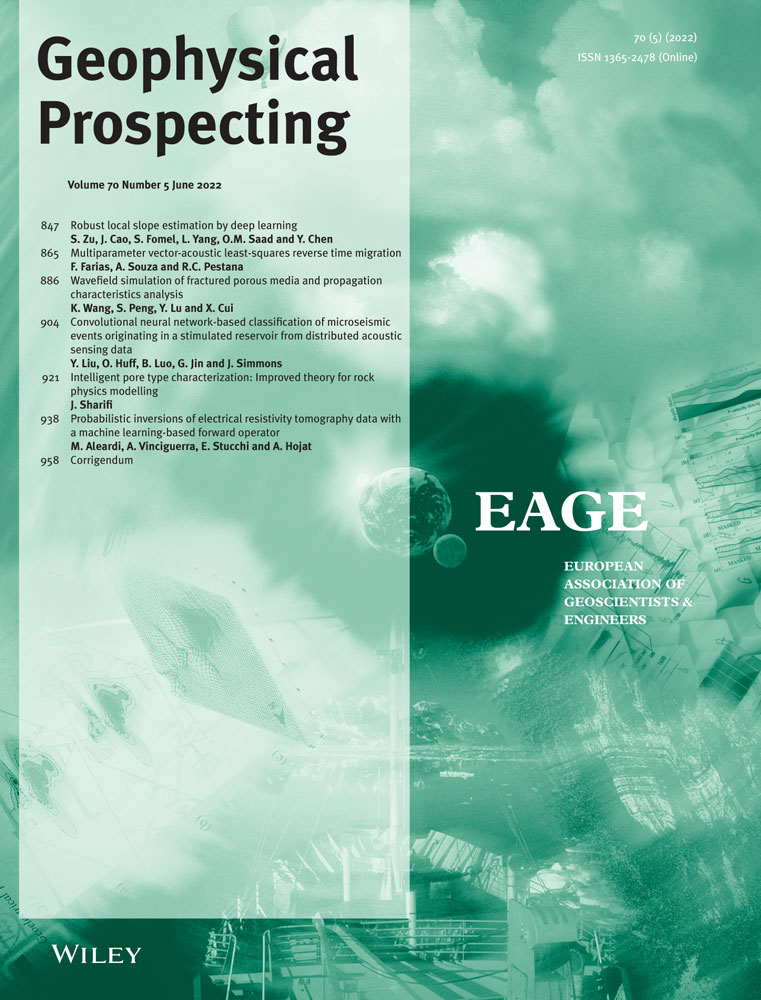Wavefield simulation of fractured porous media and propagation characteristics analysis
ABSTRACT
Most fractured reservoirs are two-phase media, that is, mixture of solid matrix and void. It contains rock skeleton and fractures or pores filled with oil, gas and water. These fractures are the channels of oil and gas storage and migration. In two-phase media, the interaction between the fluid and solid phases will further complicate the seismic wave propagation. Natural fractures are typically irregular in shape, thereby causing difficulties in the exploration of fractured reservoirs. Therefore, the key to the prediction of fractures is to study the equation of motion of seismic waves and energy distribution of seismic waves at the fracture interface. To derive the propagation law for complex irregular shape fractures in two-phase media, we combined the stiffness matrix of the media with linear slip theory and derived a numerical simulation scheme. The simulation scheme considers the fractures in the two-phase media to be in any direction. In addition, seismic wave energy distribution at the fracture interface was obtained. The linear slip boundary condition was introduced into the conventional Zoeppritz equation, and a modified Zoeppritz equation was proposed for two-phase fractured media. The reflection and transmission due to the fracture interface were considered in the new equation, thereby making the equation more flexible. Using the new numerical simulation scheme, we analysed the elastic waves produced by the linear slip fracture interface in two-phase media and provided the long-term stability results of the new scheme. Moreover, we provided the relationship between the reflection and transmission coefficients of the linear slip fracture interface and the incident angle and compliance in two-phase media using the new Zoeppritz equation. The results show that the reflection wave of two-phase fractured media can be divided into wave impedance and fracture parts to accurately describe the properties of underground rocks.
INTRODUCTION
Fractures are one of the primary targets of hydrocarbon exploration, as they are the storage spaces and connecting channels of oil and gas. The anisotropy caused by fractures can cause the dispersion of seismic wave velocity, thereby leading to inaccurate seismic imaging (Thomsen, 1995; Bakulin et al., 2000). The purpose of numerical simulation is to study seismic wave propagation characteristics, which can be used to evaluate the relationship between seismic waves and fractured media. Virieux (1986) first proposed the standard staggered-grid finite-difference method, which considers the speed and accuracy of calculation, and is currently the most commonly used method for forward modelling.
While introducing fracture, Schoenberg (1980) proposed the linear slip theory, which does not consider the fracture shape. Assuming a long wavelength (Backus, 1962), the fracture is embedded in the background medium as a plane with a thickness of approximately zero. Normal and tangential compliances were proposed to describe these fractures. At the fracture interface, the stress of the seismic wave was continuous, whereas the displacement was discontinuous (Cui et al., 2018). The change in displacement is typically determined based on the fracture compliance and stress. As fracture compliance is sensitive to fluid properties (Pyrak-Nolte & Morris, 2000), its estimation can aid in the planning and monitoring of hydraulic fracturing operations (Bakku et al., 2013). However, seismic wave propagation in a single fracture within two-phase media remains poorly understood (Minato et al., 2017). Hsu and Schoenberg (1993) further proved the accuracy of the linear slip theory. Based on the linear slip theory, Wang et al. (2020) proposed a finite-difference scheme for seismic wave propagation in horizontal and vertical fractured media under an isotropic background by combining fictitious and rotated staggered grids. The fractures are mostly inclined or irregular. Coates and Schoenberg (1995) introduced the equivalent medium theory to model arbitrary non-planar fractures. However, they only considered the fractures in isotropic background media, which could not meet the increasingly complex requirements of hydrocarbon exploration, and thus, it is necessary to derive the seismic wave propagation law for fractured media with complex backgrounds.
In fractured reservoirs, fractures typically host oil and gas, and background media contain fluid (Müller & Gurevich, 2004); thus, oil and gas reservoirs are typically two-phase media. The presence of fluids and the interaction between the fluids and solids will complicate the elastic wave propagation in two-phase media. Gassmann (1951) proposed the theory of seismic wave propagation in porous media, describing the change in the P-wave modulus caused by different fluids. Biot (1956) established the theory of fluid-saturated two-phase porous media by attributing their inelastic effect to the viscous friction and inertial coupling effect of the solids and pore fluids. Thus, he predicted the existence of a slow P-wave, which formed the basis for the wave propagation theory of two-phase porous media. White (1975) confirmed that the relative movement of pore fluids is the primary mechanism of elastic wave attenuation, along with the attenuation caused by fluid flow between the background pores and fractures. The slow P-waves observed in the experiments of Plona (1980) confirmed the accuracy of the Biot's theory. Using the Biot–Rayleigh model, Wang et al. (2019) proposed reflection and transmission coefficients for inhomogeneous plane waves on the flat interface of two-phase porous media. The theory of two-phase media fully considers the structure of media and the properties of fluid and gas; thus, two-phase media can accurately describe the structure and properties of the stratum. However, the seismic wave propagation of a single fracture in two-phase media remains to be studied.
The solutions of the Zoeppritz equation describe the seismic wave energy distribution at the interface, which is the basis of the amplitude versus offset (AVO) method. However, the solutions of the Zoeppritz equation have complex expressions, and researchers have proposed several approximate AVO equations (Aki & Richards, 1980; Smith & Gidlow, 1987; Rüger, 1998; Pšenčík & Vavryčuk, 1998). Deresiewicz and Skalak (1963) and Geertsma and Smit (1961) investigated the reflection and transmission of P-waves at the porous media interface with saturated fluid under normal incidence. Wu et al. (1990) studied the reflection and transmission of elastic waves at any incident angle at the porous media interface. All these studies were based on the hypothesis of low impedance contrast. However, these conventional AVO equations cannot consider the energy distribution law of the linear slip fracture interface, and thus, the boundary conditions of the fracture interface must be introduced into the Zoeppritz equation.
The primary objective of this study is to investigate the seismic wave propagation in two-phase fractured media, under the conditions that the fractures are mostly irregular in shape and the background media is a two-phase media. Based on the two-phase media theory and the linear slip theory, a numerical simulation scheme is proposed for two-phase fractured media, which can simulate the seismic wave propagation in two-phase media with irregular fractures. Next, we analyse the types of elastic waves caused by the fracture interface and compare the synthesized reflection waveform and the waveform generated by the simulation of the new scheme. Additionally, the Zoeppritz equation of a fracture in a two-phase medium is established, which considers the fracture interface as an independent entity that can produce reflection. The variation in incident angle and fracture compliance with reflection coefficient and transmission coefficient is explained.
THEORETICAL METHODS
Boundary conditions of linear slip fracture
Equivalent medium theory for fractures
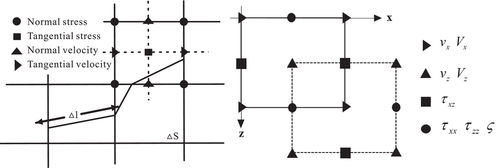
Motion equation of two-phase fractured media
Finite difference scheme
In this study, the standard staggered-grid and the first-order velocity stress two-dimensional algorithm were used to simulate seismic waves in a two-phase fractured medium (Dai et al., 1995). The staggered-grid finite-difference method divides the model into multiple grids according to a specific grid spacing and defines the variables to be calculated at each grid node, in which the stress and velocity components are defined at different positions (Virieux, 1986). Figure 1(b) shows the locations of the stress and velocity components of the two-phase medium in a standard staggered grid.
where C1 and C2 are finite-differential coefficients and different difference accuracies correspond to different finite differential coefficients. It was obtained according to Taylor expansion and first proposed by Dablain (1986). Fornberg (1998) introduced the calculation of spatial difference coefficient and discussed it in detail. When the difference accuracy is of the second order, , . When the difference accuracy is of the fourth order, , . The difference schemes of the other , , , and ς parameters can be obtained in the same way.
The long-term stability analysis reflects the ability of finite-difference scheme to control error transmission in the calculation process. For a long time period, when the numerical value is stable and does not change with time, then the difference scheme is said to be stable. The long-term stability of the velocity wave field can be calculated as , where n is the number of grids in the test model, represent the position of the grid point, and v is the velocity wave field. E is the average grid energy, which represents the average value of the square of the velocity values at all grid points for each time. When the results (grid energy) do not change, the numerical simulation scheme is regarded as having long-term stability. For details, please refer to Cheng et al. (2017).
Reflection and transmission coefficients of fracture interface
The energy distribution law of seismic waves on the fracture interface is the solution of the elastic wave equation plus interface condition, which represents the basic theory behind AVO technology. Presently, the forward and inversion modelling of AVO are based on the Zoeppritz equation of single-phase media. However, the reservoir is a two-phase medium with a solid and a fluid phase. Studying the reflection and transmission coefficients of the linear slip fracture boundary in porous media can reduce the number of multiple solutions in the AVO method while predicting reservoir parameters. The equation of reflection and transmission coefficients at the fracture interface in a two-phase medium at any incident angle is established.
Numerical simulation and discussion
We first consider two-phase isotropic elastic media with the same grid spacing in the x and z directions. The first model described in this section represents an irregular fracture interface inserted into an isotropic homogeneous background. The relevant parameters of the model are P-wave velocity and S-wave velocity . The effective density of the model medium was . The porosity of the model was . The velocity of the model flow phase was , and its effective density was . The values of the other parameters can be obtained from these six parameters. Detailed descriptions of the calculations can be found in Appendix B. The dissipation coefficients of the flow relative to the solid phase is . The model size is , the space grid parameter is , and the time step is . Figure 2(a) shows that in the model, the fracture is irregular in shape. The seismic source was buried in the horizontal centre of the model, and the fracture parameters were normal compliance and tangential compliance . The model uses the Ricker wavelet with a dominant frequency of as the source energy. The long-term stability of the new scheme was tested by running a simulation with a time of 5 s. Maintaining the parameters as constant, a pure reflection boundary was used to estimate the energy in the simulation. Figure 2(b) and (c) shows the wave field and long-term stability results, respectively. The results indicate that the proposed scheme is stable for long-term wave propagation.
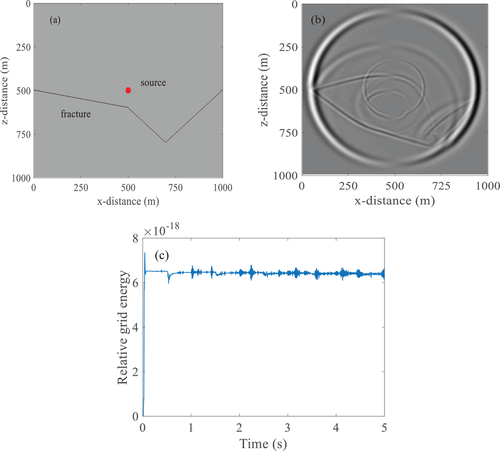
To analyse the seismic wave caused by the linear slip fracture interface, we used a single horizontal fracture and expanded the model size to 1600 × 1600 m. The seismic source was located at the centre of the model, the horizontal fracture was located 100 m below the seismic source. The remaining parameters remained unchanged. Figure 3 shows a snapshot of the wave field at 0.24 s as well as the seismic wave propagation of the model. Figure 3(a) and (b) represents the x and z components of the solid phase, respectively. Figure 3(c) and (d) represents the x and z components of the fluid phase, respectively. When the P-wave source is excited, both fast P-waves (the first type of wave) and slow P-waves (the second type of wave) are observed in the two-phase isotropic medium. Comparison of the P- and S-waves in Figure 3(a–d) shows that the velocities of the wave in the solid and fluid phases are the same. A comparison of Figure 3(a) and (c) indicates that the phases of the fast P-waves in the solid and flow phases are the same, whereas opposing phases were observed for the slow P-waves in the solid and flow phases, which is caused by the different vibrations of the fluid particles and the solid skeleton particles. All these are consistent with Biot's conclusion. Figure 3(c) and (d) show that the energy of the slow P-wave is much greater than that of the fast P-wave, such that a slow P-wave is easier to observe in the flow phase, which indicates that fast P-waves mainly propagate in the solid skeleton, while slow P-waves mainly propagate in the fluid. However, slow P-waves have a low velocity and strong attenuation and dispersion, such that it is difficult to observe in the actual seismic wave field; nevertheless, it cannot be ignored.
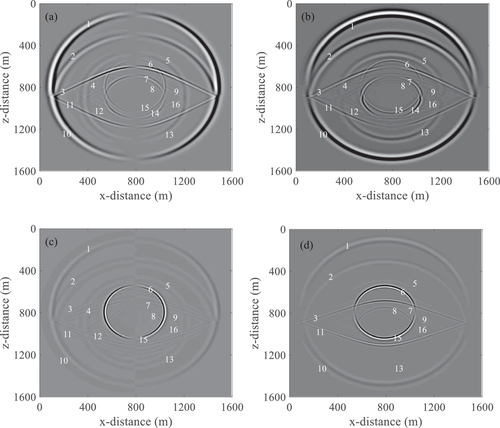
At the linear slip fracture interface of the two-phase medium, the incident, reflected and transmitted waves of the two-phase isotropic fractured medium are constrained by the boundary conditions. Since the displacement is linearly proportional to the corresponding stress, the discontinuous particle displacement will cause the wave field to contain fast P-waves (1) (Number (1) in Fig. 3), and the reflected and transmitted waves of the fast P-wave include the fast P-wave converted S-wave (3) (11), and fast P-wave converted slow P-wave (4) (12). Considering the slow P-wave (6), the reflected and transmitted waves of the slow P-wave include the slow P-wave converted to fast P-wave (5) (13), slow P-wave converted to slow P-wave (8) (15), and slow P-wave converted to shear wave (7) (14). In summary, elastic waves will produce three kinds of waves on the interface of a two-phase fracture, namely fast P-waves, slow P-waves and converted S-waves. Fast P-waves and slow P-waves will transform each other when they encounter the interface and produce transmission or reflection. This is consistent with the waveform generated by the interface of two-phase media. This proves the Backus hypothesis, which regards the fracture as a thin layer with the thickness approaching zero. In this model, the fracture can be regarded as a two-phase interface with zero thickness. In addition, because the seismic source is close to the fracture interface and reaches a critical angle, two head waves (9) (16) caused by slow P-waves (6) can also be observed, which connect the reflected fast P-wave (5) and the reflected S-wave (7), the transmitted fast P-wave (13) and the transmitted S-wave (14), respectively. Owing to the strong attenuation of the slow P-wave (6), the reflected and transmitted slow P-wave (2) (10) caused by the fast P-wave (1) is very weak; hence, it is barely observed in the vertical component of the flow phase (Fig. 3d). The reflected and transmitted slow P-waves (8) (15) caused by slow P-waves (6) can be observed. By comparing Figure 3(a–d), under the same conditions, the solid phase S-wave is obvious, while the flow phase S-wave is weak. It is difficult to observe S-wave components in the flow phase; however, this does not mean that no S-waves are present in the current phase. When the fluid is an ideal non-viscoelastic fluid, the S-wave cannot propagate through the layer. However, the fluid in a two-phase medium exists in pores, and S-waves will be able to propagate. These waves should not be ignored, even if they are very small.
To better analyse the wave field characteristics of two-phase fractured media, we designed a model wherein both the upper and lower media were two-phase media, and the fracture and impedance interfaces coincided. According to Schoenberg and Muir (1989), the compliance matrix of the fracture is added to the compliance matrix of the background medium to yield the compliance matrix of the fracture equivalent medium. In other words, the fractured medium is the linear sum of the fractured and the background medium, that is, in a fractured medium with an impedance contrast (the impedance contrast and fracture interfaces are located on the same grid boundary), the amplitude of the reflected wave caused by the interface is equal to the sum of the amplitudes of the reflected waves attributed to the fracture and to the background impedance. Figure 4 illustrates this relationship: Figure 4(a) shows the amplitude of the fast P-wave in a background medium with impedance contrast, Figure 4(b) shows the amplitude of the fast P-wave caused by a fracture interface in a uniform background medium, and Figure 4(c) shows the sum of both as well as the amplitude of the fast P-wave in a fractured medium with impedance contrast. As the synthetic reflection waveform is basically coincident with the waveform simulated by the new scheme, the fast P-wave reflection can be divided into a reflection caused by the fracture and a reflection caused by the impedance interface, which confirms the accuracy of Schoenberg and Muir's views. Therefore, in an impedance medium with fractures, the response caused by the fracture can be subtracted from the seismic data and the response caused by the impedance can be better obtained.
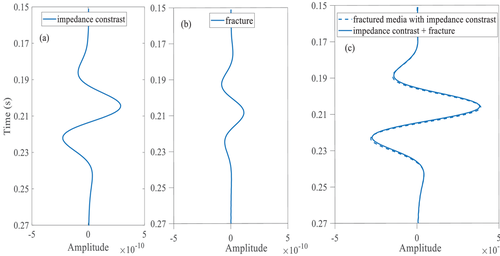
To study the effect of the fracture interface on the energy distribution of seismic waves in two-phase media, a model of two-phase isotropic background media with a single horizontal fracture was designed. The relevant parameters of the solid-phase component of the model are P-wave velocity and S-wave velocity . The effective density of the model medium is . The porosity of the model is 0.12. The velocity of the model flow phase is , and the effective density of the flow phase is . The fracture can be described by normal compliance and tangential compliance. Figure 5 shows the the amplitude spectrum (the root of the sum of the squares of the real and imaginary parts) of the reflection and transmission of the fracture interface at different incident angles. Figure 6 depicts the phase change at different incident angles. In two-phase fractured media, when the wave propagates to the fracture interface, the wave-induced flow causes the fluid to pass through it, which leads to the attenuation of propagation energy. The reflection amplitude of the fast P-waves initially decreases and then increases, and its phase angle also first decreases and then increases. The transmission amplitude increases continuously, and is one order of magnitude larger than the reflection amplitude, while the phase angle decreases continuously. As the incident angle increases, the reflection and transmission amplitude of the slow P-waves decrease accordingly, and the phase angle decreases accordingly. The transmission amplitude of the slow P-waves has a maximum at normal incidence, and its energy attenuates as the angle of incidence increases. This indicates that the slow P-wave is most likely to form when it is vertically incident. This is because, the wave has greater pressure on the fracture interface when it is vertically incident, and more fluid passes through the fracture. Due to the coupling of solid phase and liquid phase, increased slow P-waves are formed. The S-wave reflection amplitude first increases and then decreases, while the transmission amplitude first decreases and then increases. The phases of reflection and transmission of shear waves continue to decrease. When the incident angle is equal to zero, no S-wave is generated; hence, the reflection and transmission amplitude of S-wave were essentially. When the incident angle is not zero, the incident fast P-wave causes attenuation at the interface. Moreover, the original fast P-wave is converted into slow P- and S-waves, which results in greater energy loss. In two-phase fractured media, the reflection and transmission amplitudes of slow P-waves caused by fractures are 2−3 orders of magnitude smaller than those of fast P- and S-waves, while its energy also relatively small and energy attenuation speed is relatively fast. Thus, it is difficult to observe slow P-waves in surface seismic records.
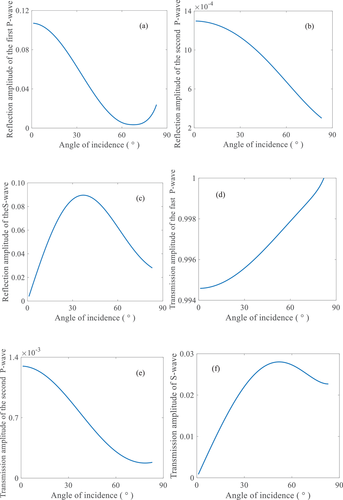
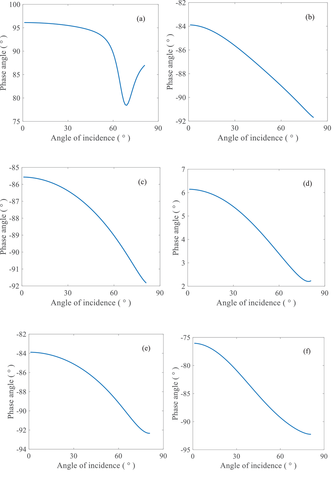
Figure 7 shows the reflection coefficient and transmission coefficient amplitude spectra for the fracture interface at different fracture compliance values. When the incident angle is 30°, the variations in the reflection and transmission amplitudes are in a compliance range of 10−50×10−10 m/Pa (Fig. 7a). With an increase in the normal compliance, SN the reflection coefficient of the fast P-wave increases, while that of the transmission coefficient decreases. In addition, the reflection and transmission amplitudes of the S-waves increase. The reflection and transmission amplitudes of slow P-waves remain essentially unchanged. With an increase in the tangential compliance ST, the reflection coefficient of the fast P-waves first decreases and then increases, while the transmission coefficient increases slowly. In addition, the S-wave reflection and transmission amplitudes both increases. The reflection and transmission amplitudes of the slow P-waves remain essentially unchanged. Therefore, a change in fracture compliance has major influence on the fast P- and S-waves, but little influence on the slow P-waves. Normal and tangential compliance have consistent effects on the reflection coefficient of the S-waves. Fracture compliance parameters can be used as indicators of fluid in fractures, i.e., the reflection amplitudes of the fast P- and S-waves are sensitive to the presence of fluid, which provides a theoretical basis for the inversion of fracture compliance parameters from seismic data.
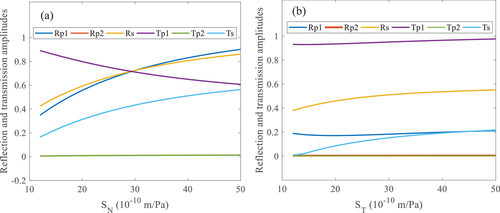
The pore structure in the actual rock is complicated, and the fluid flow in the pore structure is also complicated. When seismic waves propagate in two-phase media, Biot flow and squirt-flow are the main forms of fluid flow in porous media. Biot flow has a macroscopic nature, and it is difficult to provide a reasonable explanation for the strong attenuation and high frequency dispersion in many rocks. It is necessary to consider the jet flow (local motion) of the fluid. Dvorkin and Nur (1993) proposed to combine the Biot mechanism with the squirt-flow mechanism (Mavko & Nur, 1975). They act as a coupling process to affect wave attenuation and dispersion. When the two attenuation mechanisms are combined, since the P-wave exhibits strong attenuation, it is difficult to observe the slow P-wave in the wave field snapshot, which is not conducive to our analysis of the seismic wave propagation in the two-phase fractured medium. Only under the action of macroscopic Biot flow can the propagation mode of slow P-waves be observed, which is convenient for observing the wave field of seismic waves at the fracture interface. After fully understanding the seismic wave propagation of the fracture interface in the two-phase medium, future studies can add squirt-flow in addition to Biot flow, which can better describe the structure of underground fractures.
CONCLUSION
In this study, a new numerical simulation scheme and the Zoeppritz equation with linear slip boundary conditions are derived. In the numerical simulation scheme, the linear slip fracture interface is introduced into the stiffness matrix of the two-phase medium, which can describe the propagation of seismic waves in a two-phase fractured medium. The fractures can also result in the reflection of seismic waves. The long-term stability of the scheme is tested, proving that the scheme is accurate and stable. The linear slip fracture boundary condition is introduced into the conventional Zoeppritz equation, and the law of seismic wave energy distribution at the fracture interface in the two-phase medium is obtained. The relationship between the reflection coefficient, transmission coefficient, incident angle and fracture compliance is studied based on this equation. Numerically, the fast P-wave reflection coefficient of the two-phase fractured medium is the sum of the impedance and fracture reflection coefficients. Therefore, the new equation can describe the fracture properties independently, and it is not necessary to describe the fractured medium as an anisotropic equivalent medium. Thus, the new numerical simulation scheme and the new Zoeppritz equation can be used to estimate the fracture and rock properties in the medium to more accurately describe the underground structure and fracture properties. Under the Biot flow mechanism, slow P-waves can be observed better, which is convenient for the study of seismic wave propagation in two-phase fractured media. In subsequent research, another important attenuation mechanism, namely squirt-flow mechanism, can be considered. Combining the two mechanisms and studying the seismic wave propagation of fractures under the two mechanisms can further describe the structure of underground fractures.
APPENDIX A
In two-phase fractured media, six kinds of waves will be generated when P-waves incident from the background media to the horizontal fracture interface at α1 angle. It includes incident P-wave, two reflected P-wave, reflected S-wave, two transmitted P-wave and transmitted S-wave.
Figure A.1. Reflection and transmission on fracture interface
This set of equations (A-13) is known as the Zoeppritz equations. To ensure the correctness of the equation, it can be compared with the degenerate equation. First, in a two-phase fractured medium with an impedance contrast (the impedance contrast and the fracture interfaces are located at the same position), when the fracture compliance parameter is zero (i.e. the fracture does not exist), equations (A6)–(A11) can be decomposed to the Zoeppritz equations of a traditional two-phase medium (Lin et al., 2014). This indicates that the equation of the two-phase background medium is correct when the fracture does not exist. This also indicates that the contributions of fractures to the reflection and transmission coefficients are displayed explicitly. In other words, in a two-phase fractured medium with an impedance contrast, the reflection at the interface can be divided into the reflection caused by the fracture and the reflection at the impedance interface. Second, when the porosity of the background medium is zero, the two-phase fractured medium becomes homogeneous fractured medium. Equation (A-13) degenerates to the Zoeppritz equation of homogeneous fractured medium. This is consistent with the result obtained by Schoenberg (1980) (formula (26) in Schoenberg's article) and shows that the equation for the fracture part is correct when the background is a homogeneous medium. The formula (A-13) includes the background medium part and the fracture part. Therefore, the correctness of the equations can be guaranteed through two degenerate equations:
Equations (A-13) describe the Zoeppritz equation for two-phase horizontal fracture. When the fracture is vertical, six types of waves will also be generated when a P-wave is incident from a two-phase background medium to the fracture interface. The boundary conditions of the fracture interface are changed to discontinuous normal displacement of solid and discontinuous tangential displacement of solid . Then calculations were perform to obtain the Zoeppritz equation of the two-phase vertical fracture.
APPENDIX B
For two-phase isotropic media, it is difficult to obtain many parameters directly from seismic data. The relationship between six parameters and two-phase elastic parameters A, N, Q and R can be established by using rock-physical relationship, including P-wave velocity , S-wave velocity , density ρ, porosity ϕ, fluid velocity and fluid density . These six parameters can be obtained directly from seismic data.
It can be assumed that and . The iterative solution to equation (B-4) can be used to obtain the bulk moduli and of the framework particles.
, and are substituted into equation (1) to obtain the expressions for L and K, and subsequently the expressions for Q and R. Thus far, A, N, Q and R have been obtained.
Open Research
DATA AVAILABILITY STATEMENT
The data that support the findings of this study are available from the corresponding author upon reasonable request.



